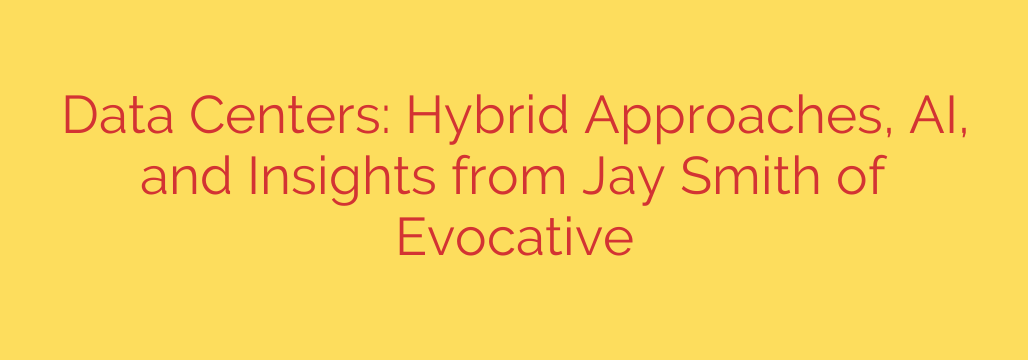
Navigating the New Era of Data Centers: Why Hybrid IT and AI Are Your Keys to Success
The conversation around IT infrastructure has fundamentally changed. For years, the debate was a simple binary: move to the public cloud or keep everything on-premise. Today, that debate is obsolete. The modern digital landscape is far more complex, driven by the explosive growth of data and the immense computational demands of Artificial Intelligence (AI).
Leading businesses are no longer choosing one path; they are building a strategic, flexible foundation known as Hybrid IT. This sophisticated approach is reshaping the role of the data center and creating new opportunities for efficiency, performance, and innovation.
The Hybrid IT Revolution: The Right Workload in the Right Place
Hybrid IT isn’t just about using a little bit of cloud and a little bit of on-premise infrastructure. It’s a deliberate strategy for optimizing your entire digital footprint. Think of it as creating a custom-built toolkit where you select the perfect tool for every single job.
The core principle of Hybrid IT is to place each workload in its most optimal environment—whether that’s on-premise, in a colocation facility, or on a public cloud platform like AWS, Azure, or Google Cloud.
Why is this so important?
- Performance: A latency-sensitive application might need to run on hardware located physically close to its users, making colocation or an on-premise solution ideal.
- Cost: Predictable, stable workloads can often be run more cost-effectively on private infrastructure, avoiding the variable, and sometimes staggering, costs of the public cloud.
- Security and Compliance: Sensitive data or workloads subject to strict regulatory requirements are often best kept in a highly secure private cloud or colocation environment where you have greater control.
A successful hybrid strategy gives you the agility of the public cloud for development and scalable applications while providing the security, performance, and cost-control of private infrastructure for your core business operations.
AI as the Catalyst: Pushing Data Centers to the Limit
If Hybrid IT is the strategy, Artificial Intelligence is the disruptive force accelerating its adoption. Training and running AI models requires a level of computing power that is pushing traditional infrastructure to its breaking point.
The public cloud can be a great place to start with AI, but many organizations quickly run into challenges with cost and data gravity—the difficulty of moving massive datasets. This is forcing a re-evaluation of where AI workloads should live.
AI workloads often require high-density racks and advanced cooling solutions, like liquid cooling, that many legacy data centers and standard cloud offerings cannot support. These high-performance computing (HPC) environments generate immense heat, and traditional air cooling is often insufficient and inefficient.
As a result, modern colocation data centers are becoming hubs for AI innovation. They provide the specialized power and cooling infrastructure necessary to run dense GPU clusters efficiently, allowing companies to build powerful AI systems without having to construct and manage a specialized facility themselves.
The Unsung Hero: Connectivity and Interconnection
A hybrid strategy is powerless without the network that ties it all together. You can have the best public cloud services and the most powerful private hardware, but if they can’t communicate effectively, the entire system fails.
This is where interconnection comes in. Interconnection refers to the private, direct, and secure network links that connect your different IT environments. Instead of sending data over the public internet, you create a dedicated, high-speed highway between your colocation space, your on-premise servers, and your public cloud providers.
Secure, low-latency interconnection is the backbone of a successful hybrid strategy, ensuring data flows seamlessly and securely between your private and public cloud environments. This robust connectivity is essential for:
- High-Speed Data Transfer: Moving large datasets for AI training or analytics.
- Low Latency: Ensuring real-time applications perform without lag.
- Enhanced Security: Reducing your exposure to threats on the public internet.
Actionable Security and Modernization Tips
Navigating this new landscape requires a proactive approach. To build a resilient and future-proof infrastructure, businesses should focus on several key areas.
Audit Your Workloads. Before making any infrastructure decisions, perform a thorough analysis of every application. Evaluate its needs based on performance, security, compliance, and cost. This audit will provide a clear roadmap for what belongs in the public cloud, what should be in a colocation facility, and what can remain on-premise.
Prioritize a Connectivity Strategy. Don’t treat your network as an afterthought. Work with a data center partner that offers robust interconnection services and direct on-ramps to major cloud providers. A well-designed network fabric is just as important as the servers and storage it connects.
Future-Proof for High-Density Demands. Even if you aren’t deploying AI at scale today, your next infrastructure move should account for it. Ask potential data center partners about their ability to support high-density power requirements and advanced cooling technologies like direct-to-chip liquid cooling. Choosing a partner who is already investing in these capabilities will prevent a costly migration later.
Unify Your Security Posture. A distributed, hybrid environment can expand your attack surface. It is crucial to implement a unified security strategy that covers everything from physical access controls at the data center to identity management and threat detection across all your cloud and private platforms. Your security policies must be consistent, no matter where an application or data resides.
The era of one-size-fits-all infrastructure is over. The future belongs to businesses that can intelligently leverage a mix of public cloud, colocation, and private resources. By focusing on strategic workload placement, investing in robust connectivity, and preparing for the demands of AI, you can build a powerful and agile foundation for long-term success. In today’s digital economy, your infrastructure strategy is your business strategy.
Source: https://datacenterpost.com/the-future-of-data-centers-hybrid-solutions-and-ai-according-to-evocatives-jay-smith/








